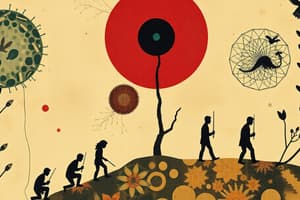Podcast
Questions and Answers
Which cellular component is primarily responsible for maintaining cellular homeostasis by regulating the transport of substances in and out of the cell?
Which cellular component is primarily responsible for maintaining cellular homeostasis by regulating the transport of substances in and out of the cell?
- Plasma Membrane (correct)
- Mitochondria
- Golgi Apparatus
- Endoplasmic Reticulum
If a bacterial cell is found to be resistant to multiple antibiotics due to changes in its DNA, which biological process best explains this phenomenon?
If a bacterial cell is found to be resistant to multiple antibiotics due to changes in its DNA, which biological process best explains this phenomenon?
- Homeostasis
- Osmosis
- Cellular Respiration
- Evolution by Natural Selection (correct)
A scientist is studying a newly discovered organism. Which characteristic would classify it as a living organism?
A scientist is studying a newly discovered organism. Which characteristic would classify it as a living organism?
- It is composed of multiple tissues.
- It can move independently.
- It can maintain a stable internal environment. (correct)
- It contains a nucleus.
In an ecosystem, what is the primary role of organisms that perform photosynthesis?
In an ecosystem, what is the primary role of organisms that perform photosynthesis?
A biologist observes that cells from a certain tissue contain a high number of mitochondria. What is the most likely function of this tissue?
A biologist observes that cells from a certain tissue contain a high number of mitochondria. What is the most likely function of this tissue?
Which process ensures that genetic information is passed from parent cells to daughter cells during cell division?
Which process ensures that genetic information is passed from parent cells to daughter cells during cell division?
A population of insects experiences a drastic change in environmental conditions, leading to a decrease in genetic diversity. Which of the following is the most likely consequence of this change?
A population of insects experiences a drastic change in environmental conditions, leading to a decrease in genetic diversity. Which of the following is the most likely consequence of this change?
A researcher is studying how different plant species respond to drought conditions. Which branch of biology is the researcher primarily working in?
A researcher is studying how different plant species respond to drought conditions. Which branch of biology is the researcher primarily working in?
Which of the following scenarios would LEAST likely lead to evolutionary change in a population?
Which of the following scenarios would LEAST likely lead to evolutionary change in a population?
How does energy flow differ from nutrient cycling within an ecosystem?
How does energy flow differ from nutrient cycling within an ecosystem?
A marathon runner primarily relies on which type of biological molecule for sustained energy during a race?
A marathon runner primarily relies on which type of biological molecule for sustained energy during a race?
How do enzymes affect the activation energy of a chemical reaction within a cell?
How do enzymes affect the activation energy of a chemical reaction within a cell?
What is the primary advantage of sexual reproduction compared to asexual reproduction?
What is the primary advantage of sexual reproduction compared to asexual reproduction?
Which of the following is an example of a positive feedback mechanism disrupting homeostasis?
Which of the following is an example of a positive feedback mechanism disrupting homeostasis?
Why are viruses considered obligate intracellular parasites?
Why are viruses considered obligate intracellular parasites?
Which molecule is the most directly responsible for translating the genetic code into proteins?
Which molecule is the most directly responsible for translating the genetic code into proteins?
In a forest ecosystem, which of the following organisms would most likely occupy the highest trophic level?
In a forest ecosystem, which of the following organisms would most likely occupy the highest trophic level?
How does catabolism contribute to overall metabolism in an organism?
How does catabolism contribute to overall metabolism in an organism?
Flashcards
Biology
Biology
The scientific study of life.
Cells
Cells
The basic structural and functional unit of life.
Biochemistry
Biochemistry
The study of the chemical processes in living organisms.
Botany
Botany
Signup and view all the flashcards
Cell biology
Cell biology
Signup and view all the flashcards
Ecology
Ecology
Signup and view all the flashcards
Genetics
Genetics
Signup and view all the flashcards
Nucleus
Nucleus
Signup and view all the flashcards
Evolution
Evolution
Signup and view all the flashcards
Ecosystem
Ecosystem
Signup and view all the flashcards
Carbohydrates
Carbohydrates
Signup and view all the flashcards
Lipids
Lipids
Signup and view all the flashcards
Proteins
Proteins
Signup and view all the flashcards
Nucleic Acids
Nucleic Acids
Signup and view all the flashcards
Metabolism
Metabolism
Signup and view all the flashcards
Homeostasis
Homeostasis
Signup and view all the flashcards
Viruses
Viruses
Signup and view all the flashcards
Study Notes
No updates are required as the new text contains precisely the same information as the existing notes.
Studying That Suits You
Use AI to generate personalized quizzes and flashcards to suit your learning preferences.




